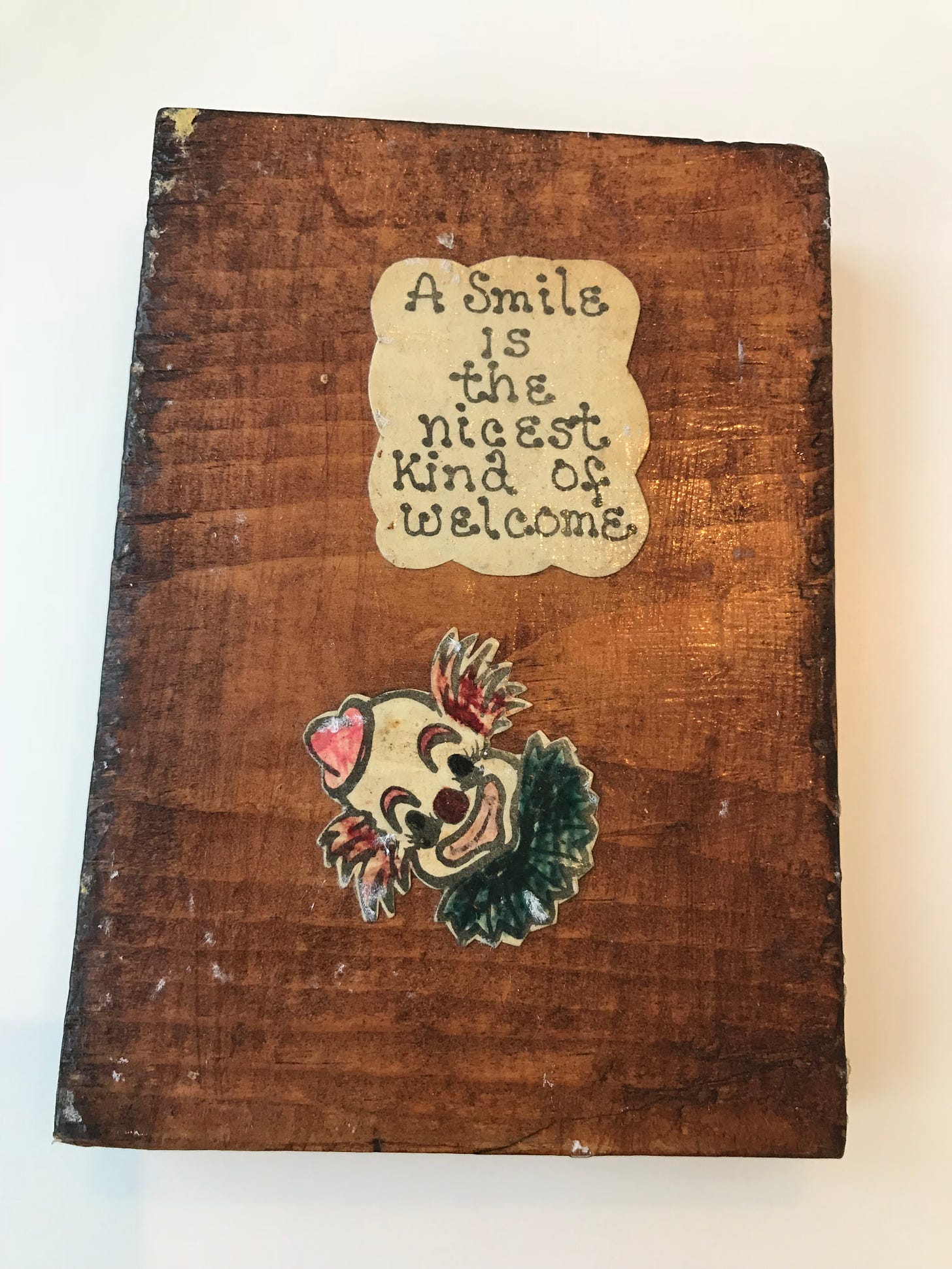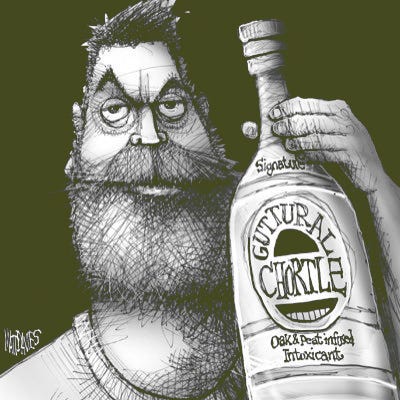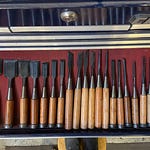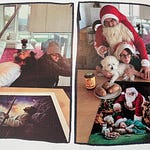WELCOME ONE AND ALL to my first bout of answering your questions, and thanks very kindly to those of you who have offered them up. They have been the figurative bottle of rum shattered across the bow of this particular creativity schooner.
It feels momentous to me. Wow! I can almost feel the blood coursing through my veins and I think that my spirits might be undergoing an arousal, for Pete’s sake. Jeez, this is wild. I feel like kicking up my heels, I’m pretty sure my dander is already up and still rising, and I’m considering throwing down. I mean this must be what they mean when they say that I’m really “feeling my oats”. By god, I’m going to hazard another rare exclamation point. Welcome!
Diana Mullins, Writer, Editor, and Educator asks:
“I'm wondering what your first woodworking project was?”
Thank you, Diana, for this question, which I have edited for brevity’s sake.
I had to give it a good think to determine which of my projects of yore would first qualify as “woodworking”. There was a treehouse, a few crude wooden weapons, and yes, projects in middle school shop class, but an earlier item occurred to me and really lit me up with emotion, so that’s the one I’ll choose.
Before we get down to business, allow me to set the scene by offering up a glimpse into my yesteryears. My memories of attending Minooka Elementary School in the 1970’s are overall pretty sunny, from what little I can recall of that distant shore. I loved the strange thrill that came with lining up near the cooler in the grade school hallway to receive our daily allotted child-sized carton of milk, during “milk break”. Some kids got chocolate milk, but I for some reason preferred regular, white 2%. No ice. A simple lad from the get-go.
I also fondly recall riding the bus to school from our three-acre homestead, literally out in the middle of a cornfield. My siblings and I were greeted daily by our benevolent driver Bonnie, who was required to perform triple-duty as babysitter and bouncer as well.
Actually, thinking about the disciplinary side of Bonnie’s job pretty quickly pisses rain on the halcyon quality of this memory set, because I immediately recall a legitimate trauma in my time commuting through the gravel dust of Bell Road.
Jamie Larkin and Chris Kiernan were the two coolest, toughest big kids who sat at the back of the bus and, I assume, smoked cigars while chewing plug tobacco and playing mumblety-peg. To my 5-year-old imagination, those two 8th graders were probably just casually stabbing each other with their switchblades, shooting up Drano™ and cussing floridly, like I always figured Fonzie was doing when the cameras weren’t rolling. (He sees the tire is flat on his motorcycle: “Ayyy, fuck.”)
For whatever reason it is that causes some humans to bully other humans, these two boys set their sights on me one day. I was only a few weeks into kindergarten when they struck. As the bus approached my house, those two felons muscularly knotted my shoelaces to the steel leg of the bus seat so that when we arrived at my stop, I couldn’t free myself and get off the bus. I still recall the ice-cold panic that washed over me as I began to sob with abandon. The bus would drive on and, cruelly orphaned, I would be tossed mercilessly into the enormous, unknown world beyond. My happy, rural life with my family was suddenly and unexpectedly coming to an end, or so it seemed.
Of course, Bonnie appeared out of nowhere and saved the day with the benevolent immediacy of Wonder Woman herself. My laces were un-knotted, my tears were dried, and I was sent skedaddling up the driveway to my home and family, emotionally reunited after those interminable minutes of abject terror and misery. I imagine the perpetrators received some middling punishment far short of the flaying I would have recommended.
Even all these years later, when I remember that act, it taps directly into my vulnerability. They hurt me in a way that I can still feel. My first impulse, then, is to say something macho about the experience, like “I’d like to run into those guys today, now that I’ve grown into a swaggering man-shaped edifice of beef and oak, and see who ends up crying like a baby.” This initial pugilistic impulse (“Oh yeah? How about I punch you?”) has long since triggered a more evolved response in me, thankfully, one that instead strives for understanding: “Ok, hold up. That was so not cool. Let’s try talking. If they’re being assholes, it’s likely because they’re in some kind of pain. Somebody at home may well be tying their laces to the figurative bus seat, so let’s consider other options besides bloodying their noses. Maybe they could use a refreshing beverage brewed from hops, or a sandwich.”
The tale of the great shoelace caper strongly represents for me the social tone of the time and place I was inhabiting. 1976, rural Illinois. I’m sure that hindsight is doing some coloring-in here, but that was the first time I remember seeing the available range of personalities in my community. “Oh, these are the cool, big kids? Um, no thank you. I’d like to see the other options please.” It was one event, I believe, that helped set me up for later creative gestures like what I’ve determined is my first woodworking project.
When I was in second grade, Mrs. Olsen was the art teacher for the whole school, grades K-5. She was intimidating from a distance but actually quite nice, and I always loved her art class. It was the only clear opportunity I had across the rather staid curriculum of those early years to be purely creative; to exercise my artistic voice, whatever that entailed. Mind you, I was never actually very good at art, but I nonetheless felt the joy of trying out weird, new ideas when I had the chance. I had a dogged propensity to put my own twist on anything I could, a trait that was quite evident in this particular project:
And there you have it. Ok, let’s break down this assignment.
You get a small rectangle of pine 1” x 6”, a small piece of paper upon which is printed a picture of a clown and a saccharine saying, some glue or paste, wood stain, and clear polyurethane finish.
Step 1— sand the pine to accept the stain (a trick. A fool’s errand - pine will never satisfactorily accept stain).
Step 2—stain the pine.
Step 3—with scissors, cut out the clown picture and the phrase of words.
Step 4—color the clown picture with what appears to have been markers (Crayola™ markers were introduced at right about this time, in 1978).
Step 5—glue the phrase and the clown to the stained pine.
Step 6—apply clear finish to the whole shebang.
Some purists will argue that in order for a project to qualify as “woodworking”, at least two pieces of wood need to be joined together, but I’ve never been terribly worried about the purists. If I flatten and oil a slab of beech for my mother to use as a cutting board, is that not woodworking? What about a turned bowl? Let’s move past nit-picking terminology and zero in on this here 70’s grade school art story, because we’re about to learn, my gentle readers, that a crime was committed.
The evidence of this crime was clear—well, clear if you were the criminal Mrs. Olsen, who was guilty of rewarding my efforts with a C+. But what was her motive? What makes good people do terrible things, like delivering such an emotional gut-punch to an eager young talent?
Forgiving the smudges of age and a perhaps questionable color palate, I think we can all agree that it is not a bad achievement at all for a seven-year-old. In later years I would gratefully learn how to apply my finish so that the brush marks were not visible, and more importantly, to simply never use stain under any circumstances. Stain blows.
Your honor, get this. Here was her justification: she pointed out to me that the clown’s head was not perfectly aligned on the vertical axis, but was instead tilted far to one side, a blunder which, in her limited perception, she could only imagine had been committed erroneously. Like I didn’t also have two eyes in my goddamn head.
“He’s a clown, Ma’am,” I replied to her, “he tilts his head at a jaunty angle. Because he’s fun.”
She narrowed her eyes at me and burped out a dubious, “Hm.” The C+ stood. I turned to the room to beseech my fellow students for the merest squeak of support, but they were silent. The brutal, narrow-minded instructor went unpunished.
So, I mean, how could I not become some stubborn-as-a-mule nonconformist? Even the so-called art teacher refused my attempts to try and live outside the box, or the envelope, or what have you. I thought this clown work was pretty good then, but I look at it now and see a goddamn masterpiece.
Thanks to all of you who made it this far—Mom and Dad, anyway, thank you as always for your support. Note that this is going to be a pretty free-associated project, so sometimes I’ll likely do a few questions, sometimes I might just do one. Sometimes I might write an homage to the elite guitar tone woods in iambic pentameter, but I actually doubt that one now that I see it typed out. But hell, you never know. If you catch me on a rare evening with a couple of pints in me, or if I get a hold of a sumo tangerine that’s gone a little round the hallucinogenic bend…
I’ll gently remind you that this is all free for the time being, then eventually the text version will remain free, but the ability to ask questions, hear the audio, and see the occasional video will be behind the paywall. In any case, the more savory questions I get from you, the better the goulash into which they will be stirred. If you don’t mind, please let me know where you’re from, and thank you. I love me a hometown, like for example mine is Minooka, Illinois. See you soon.
Sincerely,























A Smile Is the Nicest Kind of Welcome